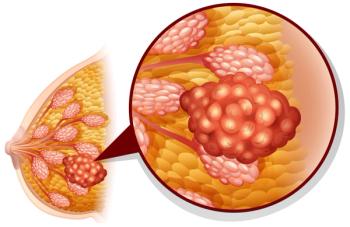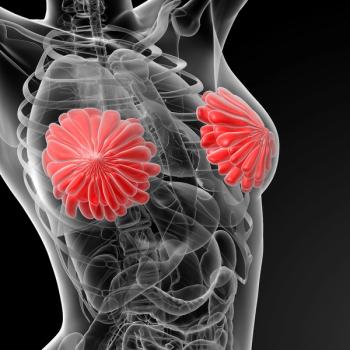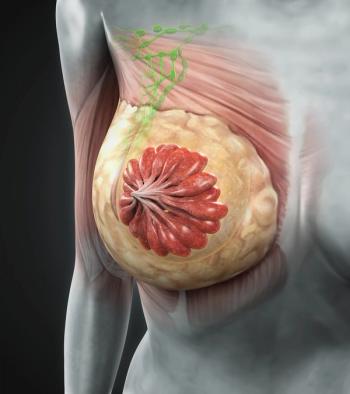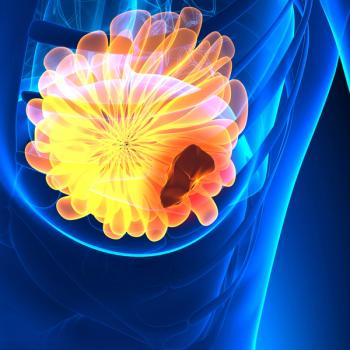
- ONCOLOGY Vol 39, Issue 7
- Volume 39
- Issue 7
- Pages: 294-296
GLP-1 Receptor Agonist Use and Weight Change in Patients With Breast Cancer
Patients with breast cancer experience significant weight loss after using GLP-1 receptor agonists, highlighting potential benefits for obesity management in this population.
Introduction
Obese-range body mass index (BMI) is an established risk factor for breast cancer recurrence, shortened breast cancer–specific survival, and overall survival.1-3 Breast cancer therapies such as chemotherapy and endocrine therapy may contribute to weight gain, worsen metabolic dysfunction, and be less effective in patients with obesity.4-7 More than two-thirds of patients gain weight following breast cancer diagnosis, which is associated with worse all-cause mortality.8-10 Large-scale lifestyle intervention studies in breast cancer survivors have demonstrated weight loss in the range of 4% to 6%, but the effect on breast cancer outcomes remains unclear, which may be due at least in part to the difficulty of maintaining weight loss over time.11-17
Glucagon-like peptide-1 receptor agonists (GLP-1 RAs) are a novel class of medications for weight management that stimulate insulin secretion after an oral glucose load, inhibit the production of glucagon at high blood sugar levels, and decrease pancreatic β-cell apoptosis.18 GLP-1 RAs were initially approved by the FDA for the treatment of type 2 diabetes based on phase 3 trials demonstrating superiority in reducing hemoglobin A1c and improving cardiovascular outcomes compared with other antihyperglycemic medications.18-22 GLP-1 RAs also induce a significant reduction in body weight through delayed gastric emptying and promotion of satiety, which has led to their study in weight management. Phase 3 clinical trials testing GLP-1 RAs for weight management have demonstrated mean weight reduction of 8% to 15%, with 63% to 86% of patients achieving a 5% or greater reduction in body weight, and 33% to 69% achieving a 10% or greater reduction after 13 to 17 months of use.23-25 The FDA-approved indication for weight management use of GLP-1 RAs is a BMI of 30 or higher, or a BMI of 27 or higher with at least 1 other cardiometabolic comorbidity such as type 2 diabetes or hyperlipidemia. Notably, a cancer diagnosis is not currently a qualifying comorbidity for GLP-1 RA treatment. Whether GLP1-RAs induce a similar magnitude of weight loss in patients with breast cancer, particularly those concurrently receiving endocrine therapy (ET), is unknown. In this study, we aim to investigate the magnitude of weight change in patients with breast cancer who received GLP-1 RAs.
Methods
Patients with a breast cancer diagnosis were prescribed GLP-1 RAs from January 1, 2015, to December 31, 2023, at Memorial Sloan Kettering Cancer Center in New York, New York, with follow-up weight data (before and during treatment with a GLP-1 RA) included in this retrospective cohort. GLP-1 RA treatment dates were identified based on prescription records. Demographic and clinicopathologic characteristics were abstracted from medical records. Weights were measured during clinic visits and were categorized by time from initiation of GLP-1 RA at 6 months or 12 months; any weight within 2 months before or after the specified time point was recorded. A linear mixed effects model with a random intercept for baseline patient weight was used to assess mean weight change at each available follow-up time point. Relative weight change from baseline to 12 months (+/–2 months) after GLP-1 RA initiation (as a percentage for those patients who had their weight reported at this time point) was also computed, and univariable and multivariable logistic regression models were fitted to assess the associations of baseline covariates with relative weight change. These covariates included patient characteristics as well as tumor characteristics known to have associations with BMI, including stage at diagnosis, histology, and breast cancer subtype.26,27 Relative weight change at the 12-month time point was also compared using the Wilcoxon rank-sum test in patients who received concurrent ET and those who did not.
Results
A total of 116 patients with breast cancer were identified by GLP-1 RA prescriptions. Among them, 75 patients had both a baseline pre–GLP-1 RA and during GLP-1 RA treatment weight recorded and thus were included in this study. Baseline characteristics are shown in the Table. Fifty-nine (79%) patients had a diabetes diagnosis; 44 (59%) patients received metformin, 43 (57%) received an SGLT2 inhibitor, and 37 (49%) received insulin concurrently with GLP-1 RA. Median BMI at breast cancer diagnosis was 32 (range, 20-53); median BMI at GLP-1 RA initiation was 34 (range, 23-50). The median time from breast cancer diagnosis to GLP-1 RA initiation was 4.3 years (range, –4.4 to 29.5), and the median duration of GLP-1 RA use was 20 months (range, 6-111 months). Thirty-seven (49%) patients used liraglutide, 45 (60%) used semaglutide, 13 (17%) used exenatide, 6 (8%) used dulaglutide, and 8 (11%) used tirzepatide; 29 patients had used 1 or more GLP-1 RAs. In the linear mixed effects model, mean weight change at 6 months was –2.9 kg (95% CI, –4.1 to –1.7) and at 12 months was –4.2 kg (95% CI, –5.5 to –2.9). The mean weight change from baseline to 12 months in terms of percentage of baseline weight was –5% (95% CI, –6% to –3%). Among patients without diabetes, mean weight change from baseline to 12 months was also –5% (95% CI, –11% to 0%). Ten (13%) patients changed BMI categories from initiation of GLP-1 RA to 12 months. Seven (9.3%) were obese and changed category to overweight, and 2 (2.7%) were overweight and changed category to normal BMI; 1 patient (1.3%) was overweight and changed category to obese. In univariable and multivariable analyses, age, race, ethnicity, baseline BMI, diabetes diagnosis, breast cancer stage, histology, breast cancer subtype, and menopausal status were not significantly associated with having 5% or greater weight loss at
12 months after GLP-1 RA initiation (Figure). Similarly, concurrent ET use was not significantly associated with 5% or greater weight loss in univariable (OR, 0.78; P =.7) or multivariable analysis (OR; 1.01; P >.9). The median weight change in patients using concurrent ET was –3% (range, –18% to 9%) and in patients not using concurrent ET was –5% (range, –22% to 4%, P =.5).
Discussion
In this retrospective cohort study, patients with breast cancer who received a GLP-1 RA for diabetes or weight management had a mean weight loss of 5% after 12 months. There were no clinicopathologic variables significantly associated with 5% or greater weight loss.
The observed weight loss in this study is in line with previously reported trials testing lifestyle interventions in the context of breast cancer. In the interventional LISA study (NCT00463489), which tested telephone-based lifestyle counseling, participants who received the behavioral intervention had a mean weight loss of 5.5% at 12 months.28 In the phase 3 BWEL study (NCT02750826), which also tested telephone-based weight loss counseling, participants had a mean weight loss of 4.8% at 12 months.29 Compared with the phase 3 GLP-1 RA trials that led to FDA approval, a lower percentage of weight reduction was seen in our study. Potential reasons for this include: (1) 79% of our patients used a GLP-1 RA for an indication of diabetes rather than weight management, and (2) interactions with breast cancer treatments such as chemotherapy, chemotherapy supportive medications such as steroids, and/or endocrine therapy, which exacerbate metabolic dysfunction and contribute to weight gain, may attenuate weight loss with a GLP-1 RA.4
Preclinical studies of GLP-1 RAs have shown promising antitumor activity in breast cancer, though it is unclear whether these effects are direct or indirect via energy restriction. Treatment of breast cancer cells with the long-acting GLP-1 RA exendin-4 induced cAMP elevation, inhibited cell growth, and enhanced apoptosis.30 The effect of exendin-4 on attenuating breast cancer cell proliferation and reducing tumor size occurs in a dose-dependent manner and has also been demonstrated to inhibit NF-kB activation.31 Clinically, GLP-1 RA use in patients with diabetes is associated with significant primary risk reduction of several obesity-associated cancers.32 In patients with breast cancer, lifestyle intervention trials have shown improvements in breast cancer outcomes. In the Women’s Intervention Nutrition Study, where participants in the intervention arm lost an average of 2.7 kg more than those in the control group, there was a significant improvement in relapse-free survival (HR, 0.76; 95% CI, 0.60-0.98).33 In the DIANA-5 study (NCT05019989), patients in the upper tertile of adherence to the lifestyle intervention had lower rates of recurrence (HR, 0.59; 95% CI, 0.36-0.92).34 These studies suggest that the impact of lifestyle interventions on breast cancer recurrence may be mediated by effective weight loss and adherence, and importantly, even modest weight change can be associated with meaningful clinical benefit. Weight loss recommendations may be particularly important for patients at highest risk for weight gain and cardiovascular morbidity, such as young/premenopausal patients, postmenopausal patients with estrogen receptor–positive disease on endocrine therapy, and/or preexisting cardiovascular disease risk factors.34,35
Our study should be interpreted within the context of its limitations, including the observational design and heterogeneous cohort of patients with breast cancer, most of whom received a GLP-1 RA for diabetes rather than weight management. Nonetheless, both indications were included in this study as weight loss is typically induced when GLP-1 RAs are used for diabetes management. Weight data were collected from patient charts; pre- and on-treatment measured weights were available in only 64.6% of patients treated with a GLP-1 RA. Lastly, we included a heterogeneous breast cancer cohort and did not evaluate cancer outcomes, as the primary objective was to assess weight change. Trials that establish the optimal dosing of GLP-1 RAs for effective weight loss in patients with breast cancer, particularly those on endocrine therapies, are requisite for probing the potential anticancer impact.
References
- Ewertz M, Jensen MB, Gunnarsdóttir KÁ, et al. Effect of obesity on prognosis after early-stage breast cancer. J Clin Oncol. 2011;29(1):25-31. doi:10.1200/JCO.2010.29.7614
- Chan DSM, Vieira AR, Aune D, et al. Body mass index and survival in women with breast cancer-systematic literature review and meta-analysis of 82 follow-up studies. Ann Oncol. 2014;25(10):1901-1914. doi:10.1093/annonc/mdu042
- Harborg S, Cronin-Fenton D, Jensen MBR, Ahern TP, Ewertz M, Borgquist S. Obesity and risk of recurrence in patients with breast cancer treated with aromatase inhibitors. JAMA Netw Open. 2023;6(10):e2337780. doi:10.1001/jamanetworkopen.2023.37780
- Dieli-Conwright CM, Wong L, Waliany S, Bernstein L, Salehian B, Mortimer JE. An observational study to examine changes in metabolic syndrome components in patients with breast cancer receiving neoadjuvant or adjuvant chemotherapy. Cancer. 2016;122(17):2646-2653. doi:10.1002/cncr.30104
- Desmedt C, Fornili M, Clatot F, et al. Differential benefit of adjuvant docetaxel-based chemotherapy in patients with early breast cancer according to baseline body mass index. J Clin Oncol. 2020;38(25):2883-2891. doi:10.1200/JCO.19.01771
- Pfeiler G, Königsberg R, Fesl C, et al. Impact of body mass index on the efficacy of endocrine therapy in premenopausal patients with breast cancer: an analysis of the prospective ABCSG-12 trial. J Clin Oncol. 2011;29(19):2653-2659. doi:10.1200/JCO.2010.33.2585
- Vance V, Mourtzakis M, McCargar L, Hanning R. Weight gain in breast cancer survivors: prevalence, pattern and health consequences. Obes Rev. 2011;12(4):282-294. doi:10.1111/j.1467-789X.2010.00805.x
- Raghavendra A, Sinha AK, Valle-Goffin J, Shen Y, Tripathy D, Barcenas CH. Determinants of weight gain during adjuvant endocrine therapy and association of such weight gain with recurrence in long-term breast cancer survivors. Clin Breast Cancer. 2018;18(1):e7-e13. doi:10.1016/j.clbc.2017.11.006
- Playdon MC, Bracken MB, Sanft TB, Ligibel JA, Harrigan M, Irwin ML. Weight gain after breast cancer diagnosis and all-cause mortality: systematic review and meta-analysis. J Natl Cancer Inst. 2015;107(12):djv275. doi:10.1093/jnci/djv275
- Irwin ML, McTiernan A, Baumgartner RN, et al. Changes in body fat and weight after a breast cancer diagnosis: influence of demographic, prognostic, and lifestyle factors. J Clin Oncol. 2005;23(4):774-782. doi:10.1200/JCO.2005.04.036
- Chlebowski RT, Blackburn GL, Hoy MK, et al. Survival analyses from the Women’s Intervention Nutrition Study (WINS) evaluating dietary fat reduction and breast cancer outcome. J Clin Oncol. 2008;26(suppl 15):522. doi:10.1200/jco.2008.26.15_suppl.522
- Pierce JP, Natarajan L, Caan BJ, et al. Influence of a diet very high in vegetables, fruit, and fiber and low in fat on prognosis following treatment for breast cancer: the Women’s Healthy Eating and Living (WHEL) randomized trial. JAMA. 2007;298(3):289-298. doi:10.1001/jama.298.3.289
- Demark-Wahnefried W, Jones LW, Snyder DC, et al. Daughters and Mothers Against Breast Cancer (DAMES): main outcomes of a randomized controlled trial of weight loss in overweight mothers with breast cancer and their overweight daughters. Cancer. 2014;120(16):2522-2534. doi:10.1002/cncr.28761
- Rock CL, Flatt SW, Byers TE, et al. Results of the Exercise and Nutrition to Enhance Recovery and Good Health for You (ENERGY) trial: a behavioral weight loss intervention in overweight or obese breast cancer survivors. J Clin Oncol. 2015;33(28):3169-3176. doi:10.1200/JCO.2015.61.1095
- Anderson C, Harrigan M, George SM, et al. Changes in diet quality in a randomized weight loss trial in breast cancer survivors: the lifestyle, exercise, and nutrition (LEAN) study. NPJ Breast Cancer. 2016;2:16026. doi:10.1038/npjbcancer.2016.26
- Ligibel JA, Barry WT, Alfano C, et al. Randomized phase III trial evaluating the role of weight loss in adjuvant treatment of overweight and obese women with early breast cancer (Alliance A011401): study design. NPJ Breast Cancer. 2017;3:37. doi:10.1038/s41523-017-0040-8
- Chlebowski RT, Blackburn GL, Thomson CA, et al. Dietary fat reduction and breast cancer outcome: interim efficacy results from the Women’s Intervention Nutrition Study. J Natl Cancer Inst. 2006;98(24):1767-1776. doi:10.1093/jnci/djj494
- Drucker DJ. Mechanisms of action and therapeutic application of glucagon-like peptide-1. Cell Metab. 2018;27(4):740-756. doi:10.1016/j.cmet.2018.03.001
- Garvey WT, Birkenfeld AL, Dicker D, et al. Efficacy and safety of liraglutide 3.0 mg in individuals with overweight or obesity and type 2 diabetes treated with basal insulin: the SCALE insulin randomized controlled trial. Diabetes Care. 2020;43(5):1085-1093. doi:10.2337/dc19-1745
- Marso SP, Daniels GH, Brown-Frandsen K, et al; LEADER Steering Committee; LEADER Trial Investigators. Liraglutide and cardiovascular outcomes in type 2 diabetes. N Engl J Med. 2016;375(4):311-322. doi:10.1056/NEJMoa1603827
- Aroda VR, Bain SC, Cariou B, et al. Efficacy and safety of once-weekly semaglutide versus once-daily insulin glargine as add-on to metformin (with or without sulfonylureas) in insulin-naive patients with type 2 diabetes (SUSTAIN 4): a randomised, open-label, parallel-group, multicentre, multinational, phase 3a trial. Lancet Diabetes Endocrinol. 2017;5(5):355-366. doi:10.1016/S2213-8587(17)30085-2
- Marso SP, Bain SC, Consoli A, et al; SUSTAIN-6 Investigators. Semaglutide and cardiovascular outcomes in patients with type 2 diabetes. N Engl J Med. 2016;375(19):1834-1844. doi:10.1056/NEJMoa1607141
- Pi-Sunyer X, Astrup A, Fujioka K, et al; SCALE Obesity and Prediabetes NN8022-1839 Study Group. A randomized, controlled trial of 3.0 mg of liraglutide in weight management. N Engl J Med. 2015;373(1):11-22. doi:10.1056/NEJMoa1411892
- Wilding JPH, Batterham RL, Calanna S, et al; STEP 1 Study Group. Once-weekly semaglutide in adults with overweight or obesity. N Engl J Med. 2021;384(11):989-1002. doi:10.1056/NEJMoa2032183
- Jastreboff AM, Aronne LJ, Ahmad NN, et al; SURMOUNT-1 Investigators. Tirzepatide once weekly for the treatment of obesity. N Engl J Med. 2022;387(3):205-216. doi:10.1056/NEJMoa2206038
- Bellini A, Keegan THM, Li Q, et al. The effect of body mass index on breast cancer stage and breast cancer specific survival. Breast Cancer Res Treat. 2025;211(3):649-656. doi:10.1007/s10549-025-07678-7
- Luís C, Dias J, Firmino-Machado J, et al. A retrospective study in tumour characteristics and clinical outcomes of overweight and obese women with breast cancer. Breast Cancer Res Treat. 2023;198(1):89-101. doi:10.1007/s10549-022-06836-5
- Goodwin PJ, Segal RJ, Vallis M, et al. The LISA randomized trial of a weight loss intervention in postmenopausal breast cancer. npj Breast Cancer 2020;6(1):6.
- Ligibel JA, Ballman KV, McCall LM, et al. Effect of a telephone-based weight loss intervention (WLI) on weight at 12-months in women with early breast cancer: results from the Breast Cancer Weight Loss (BWEL) trial. J Clin Oncol. 2023;41(suppl 16):12001. doi:10.1200/JCO.2023.41.16_suppl.12001
- Ligumsky H, Wolf I, Israeli S, et al. The peptide-hormone glucagon-like peptide-1 activates cAMP and inhibits growth of breast cancer cells. Breast Cancer Res Treat. 2012;132(2):449-461. doi:10.1007/s10549-011-1585-0
- Iwaya C, Nomiyama T, Komatsu S, et al. Exendin-4, a glucagonlike peptide-1 receptor agonist, attenuates breast cancer growth by inhibiting NF-κB activation. Endocrinology. 2017;158(12):4218-4232. doi:10.1210/en.2017-00461
- Wang L, Xu R, Kaelber DC, Berger NA. Glucagon-like peptide 1 receptor agonists and 13 obesity-associated cancers in patients with type 2 diabetes. JAMA Netw Open. 2024;7(7):e2421305. doi:10.1001/jamanetworkopen.2024.21305
- Berrino F, Villarini A, Gargano G, et al. The effect of diet on breast cancer recurrence: the DIANA-5 randomized trial. Clin Cancer Res. 2024;30(5):965-974. doi:10.1158/1078-0432.CCR-23-1615
- Hershman DL, Till C, Shen S, et al. Association of cardiovascular risk factors with cardiac events and survival outcomes among patients with breast cancer enrolled in SWOG clinical trials. J Clin Oncol. 2018;36(26):2710-2717. doi:10.1200/JCO.2017.77.4414
- Uhelski ACR, Blackford AL, Sheng JY. Factors associated with weight gain in pre- and post-menopausal women receiving adjuvant endocrine therapy for breast cancer. J Cancer Surviv. 2024;18(5):1683-1696. doi:10.1007/s11764-023-01408-y
Articles in this issue
Newsletter
Stay up to date on recent advances in the multidisciplinary approach to cancer.





